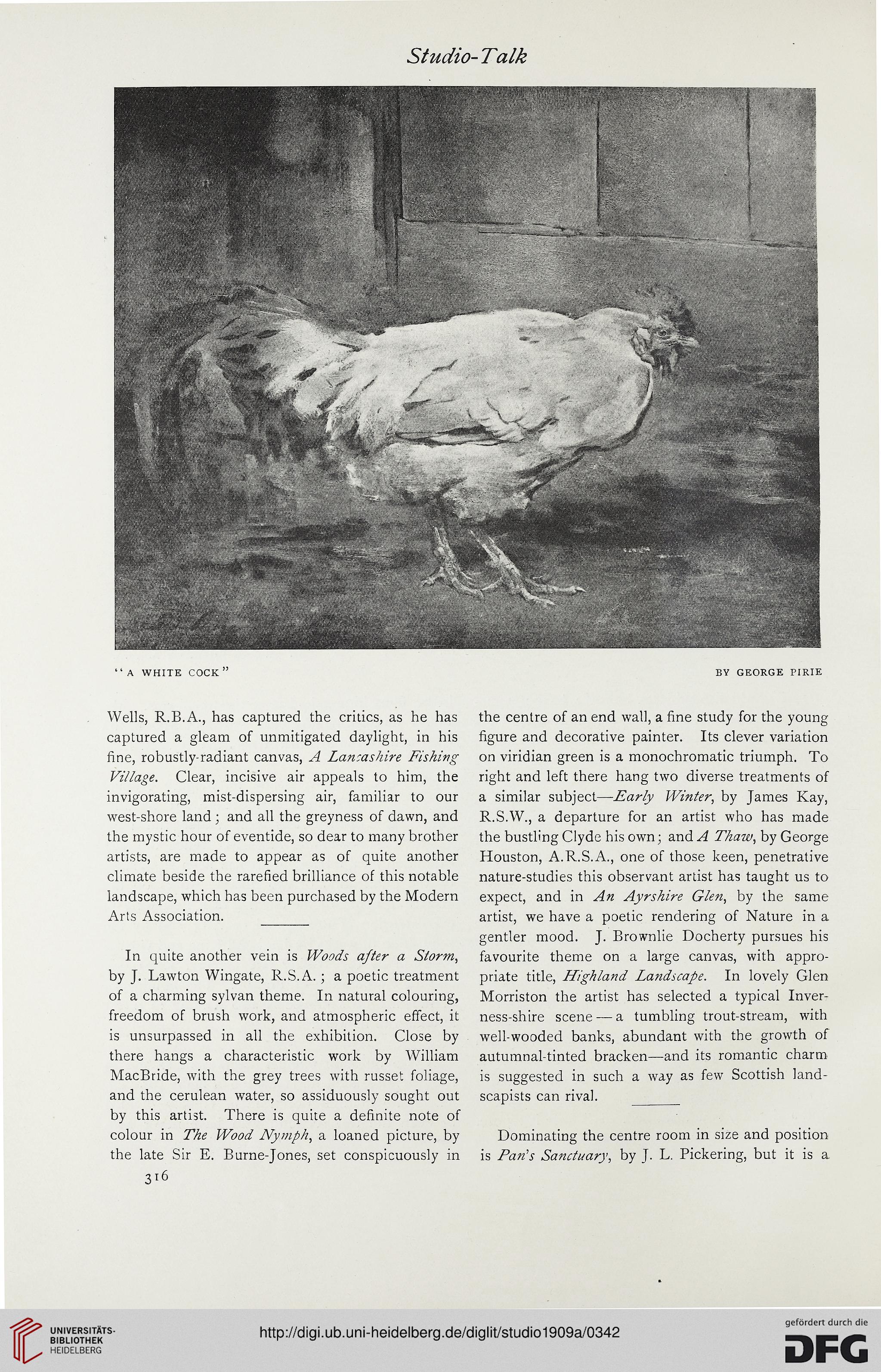Studio-Talk
“A WHITE COCK” BY GEORGE PIRIE
Wells, R.B.A., has captured the critics, as he has
captured a gleam of unmitigated daylight, in his
fine, robustly-radiant canvas, A Lancashire Fishing
Village. Clear, incisive air appeals to him, the
invigorating, mist-dispersing air, familiar to our
west-shore land ; and all the greyness of dawn, and
the mystic hour of eventide, so dear to many brother
artists, are made to appear as of quite another
climate beside the rarefied brilliance of this notable
landscape, which has been purchased by the Modern
Arts Association.
In quite another vein is Woods after a Storm,
by J. Lawton Wingate, R.S.A.; a poetic treatment
of a charming sylvan theme. In natural colouring,
freedom of brush work, and atmospheric effect, it
is unsurpassed in all the exhibition. Close by
there hangs a characteristic work by William
MacBride, with the grey trees with russet foliage,
and the cerulean water, so assiduously sought out
by this artist. There is quite a definite note of
colour in The Wood Nymph, a loaned picture, by
the late Sir E. Burne-Jones, set conspicuously in
316
the centre of an end wall, a fine study for the young
figure and decorative painter. Its clever variation
on viridian green is a monochromatic triumph. To
right and left there hang two diverse treatments of
a similar subject—Early Winter, by James Kay,
R.S.W., a departure for an artist who has made
the bustling Clyde his own; and A Thaw, by George
Houston, A.R.S.A., one of those keen, penetrative
nature-studies this observant artist has taught us to
expect, and in An Ayrshire Glen, by the same
artist, we have a poetic rendering of Nature in a
gentler mood. J. Brownlie Docherty pursues his
favourite theme on a large canvas, with appro-
priate title, Highland La?idscape. In lovely Glen
Morriston the artist has selected a typical Inver-
ness-shire scene — a tumbling trout-stream, with
well-wooded banks, abundant with the growth of
autumnal-tinted bracken—and its romantic charm
is suggested in such a way as few Scottish land-
scapists can rival. _
Dominating the centre room in size and position
is Pan's Sanctuary, by J. L. Pickering, but it is a
“A WHITE COCK” BY GEORGE PIRIE
Wells, R.B.A., has captured the critics, as he has
captured a gleam of unmitigated daylight, in his
fine, robustly-radiant canvas, A Lancashire Fishing
Village. Clear, incisive air appeals to him, the
invigorating, mist-dispersing air, familiar to our
west-shore land ; and all the greyness of dawn, and
the mystic hour of eventide, so dear to many brother
artists, are made to appear as of quite another
climate beside the rarefied brilliance of this notable
landscape, which has been purchased by the Modern
Arts Association.
In quite another vein is Woods after a Storm,
by J. Lawton Wingate, R.S.A.; a poetic treatment
of a charming sylvan theme. In natural colouring,
freedom of brush work, and atmospheric effect, it
is unsurpassed in all the exhibition. Close by
there hangs a characteristic work by William
MacBride, with the grey trees with russet foliage,
and the cerulean water, so assiduously sought out
by this artist. There is quite a definite note of
colour in The Wood Nymph, a loaned picture, by
the late Sir E. Burne-Jones, set conspicuously in
316
the centre of an end wall, a fine study for the young
figure and decorative painter. Its clever variation
on viridian green is a monochromatic triumph. To
right and left there hang two diverse treatments of
a similar subject—Early Winter, by James Kay,
R.S.W., a departure for an artist who has made
the bustling Clyde his own; and A Thaw, by George
Houston, A.R.S.A., one of those keen, penetrative
nature-studies this observant artist has taught us to
expect, and in An Ayrshire Glen, by the same
artist, we have a poetic rendering of Nature in a
gentler mood. J. Brownlie Docherty pursues his
favourite theme on a large canvas, with appro-
priate title, Highland La?idscape. In lovely Glen
Morriston the artist has selected a typical Inver-
ness-shire scene — a tumbling trout-stream, with
well-wooded banks, abundant with the growth of
autumnal-tinted bracken—and its romantic charm
is suggested in such a way as few Scottish land-
scapists can rival. _
Dominating the centre room in size and position
is Pan's Sanctuary, by J. L. Pickering, but it is a




